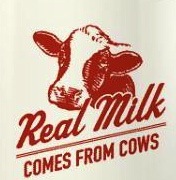There was a time, not too long ago, when American’s milk options were limited to various forms of cow’s milk (i.e. full-fat, reduced-fat, skim, lactose-free). But times have changed. Soy was the first non-dairy milk to “go mainstream” in the mid 1990s, and you can find “milk” varieties including almond, coconut, hazelnut, hemp, oat, and sunflower seed on supermarket shelves,
Much like an only child who is the center of attention until a sibling comes along, Big Dairy has started to lash out. “Alternative milks” are no longer relegated to the vegan world; many vegetarians and omnivores also purchase and consume plant-based milks. This is bad news for Big Dairy (a.k.a. The California Milk Processor Board).
Behold their latest campaign — “Real Milk Comes From Cows” (tagline: “many imitations, still no equal”). The idea, apparently, is to point out all the ways in which plant-based milks have cooties. One of their inane recent ads can be seen in the screenshot below:
Coconut milk is described as “spooky” for looking so “real,” or similar to cow’s milk. Hazelnut milk is supposed to creep us out because of the “stuff on the bottom,” Almond milk is dissed for having a “funky” color, and soy milk is unveiled as a product that doesn’t come from a cow (when did it ever claim to?).
This campaign wants to sell the idea that only dairy milk is “real.” Other milks, we are supposed to believe, are “not natural” and have long ingredient lists with questionable ingredients. Now, for the fun part: pointing out how misguided, inaccurate, and illogical this campaign is.
- Carrageenan — a seaweed extract used to impart a creamy mouth feel to some commercial plant milks — is highlighted in this campaign as a sketchy ingredient. Its safety was called into question after a 2001 literature review in Environmental Health Perspectives. In 2003, the Joint Food and Agriculture Organization/World Health Organization Expert Committee on Food Additives, which had declared carrageenan safe in 1998, but reopened the case after that 2001 literature review, reaffirmed that carrageenan was safe for consumption [PDF]. Regardless, carrageenan is not present in all commercial plant milks. As reader Brent points out, carrageenan is sometimes in dairy products, too (i.e. heavy cream).
- Carob bean gum, guar gum, and xanthan gum are also pointed out, seemingly to show how “artificial” these plant milks are. The first two gums are made by simply dehusking and milling respective beans into a powder. Xanthan gum, meanwhile, is the end result of sugar fermentation. They are worlds apart from chemical additives, artificial sweeteners, or artificial dyes. And, as with carrageenan, not all plants milk contain these gums.
- All plant milks can be made at home with a blender and a nutmilk bag, so it is possible (and very easy!) to drink these without any added ingredients.
- The bottle of “real milk” in this campaign contains skim milk. Come again? Now, I’d say “Real milk” is what comes straight from the cow — and it ain’t skim.
- While the dairy industry point to the “weirdness” of hazelnut milk’s “stuff at the bottom.” Talk to any dairy purist and they will tell you that “real milk” is non-homogenized (aka, “the cream rises to the top”). So, if anything, real milk doesn’t have a uniform look. But, remember, this is Big Dairy. This is not about a small farmer who produces non-homogenized organic milk from pastured cows. This is CAFO-made, corn and grain-fed milk from cows that, very likely, are treated with hormones and antibiotics.
- You can see more of their desperate attacks on plant milks in this TV spot, titled “Shake.”
Big Dairy is clearly afraid. Once the lone shining star, it now has no option but to coexist among others that are rising in popularity. It’s worthy of a screenplay; one that showcases the plummeting fall from grace of a once-renowned A-lister. It may be time to start penning Dairy Dearest …
This post originally appeared on Small Bites.



